Abstract
Chronic sleep disturbance, such as bed refusal, sleep-onset delay, and night waking with crying, affects 15% to 35% of preschool children. Biological factors, particularly arousals associated with recurrent episodes of rapid-eye-movement sleep, render infants vulnerable to repeated awakenings. Parental failure to establish appropriate stimulus control of sleep-related behaviors and parent-mediated contingencies of reinforcement for sleep-incompatible behaviors may shape and maintain infant sleep disturbance. Treatment and prevention strategies are discussed, and research needs are identified.
Full text
PDF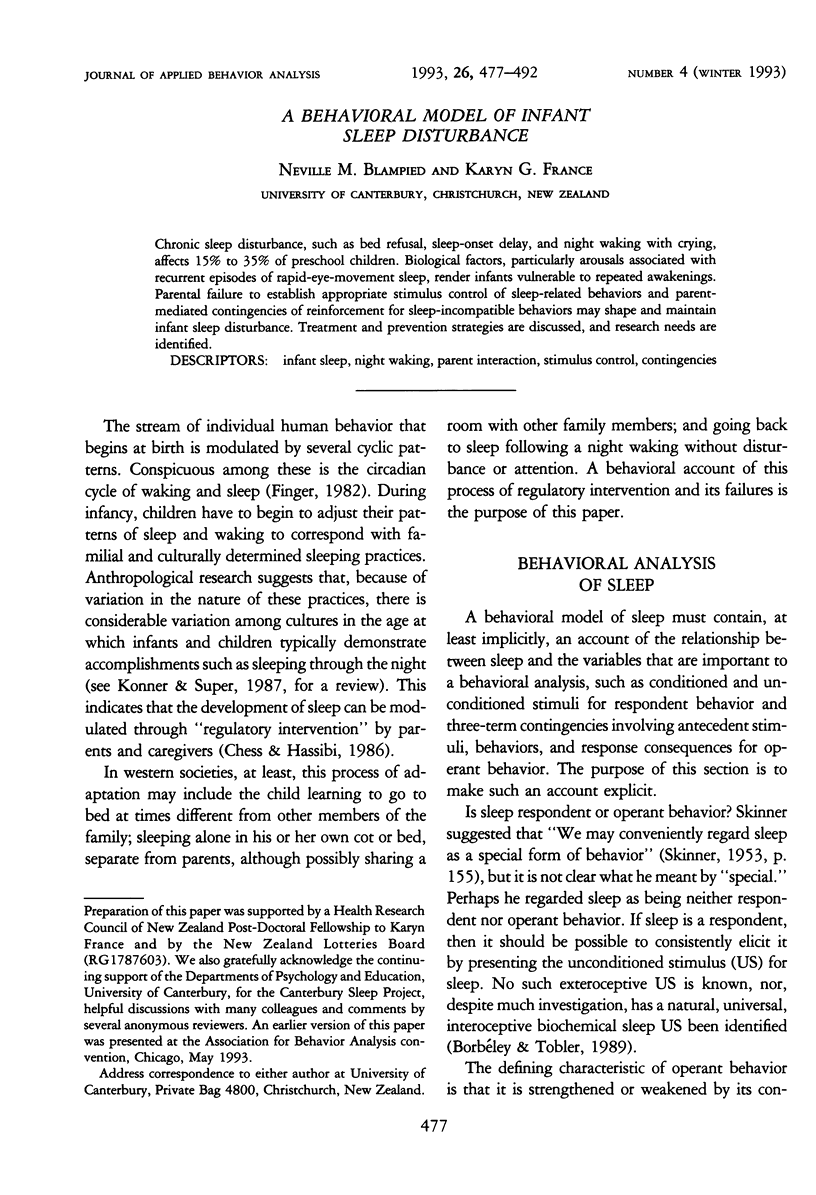


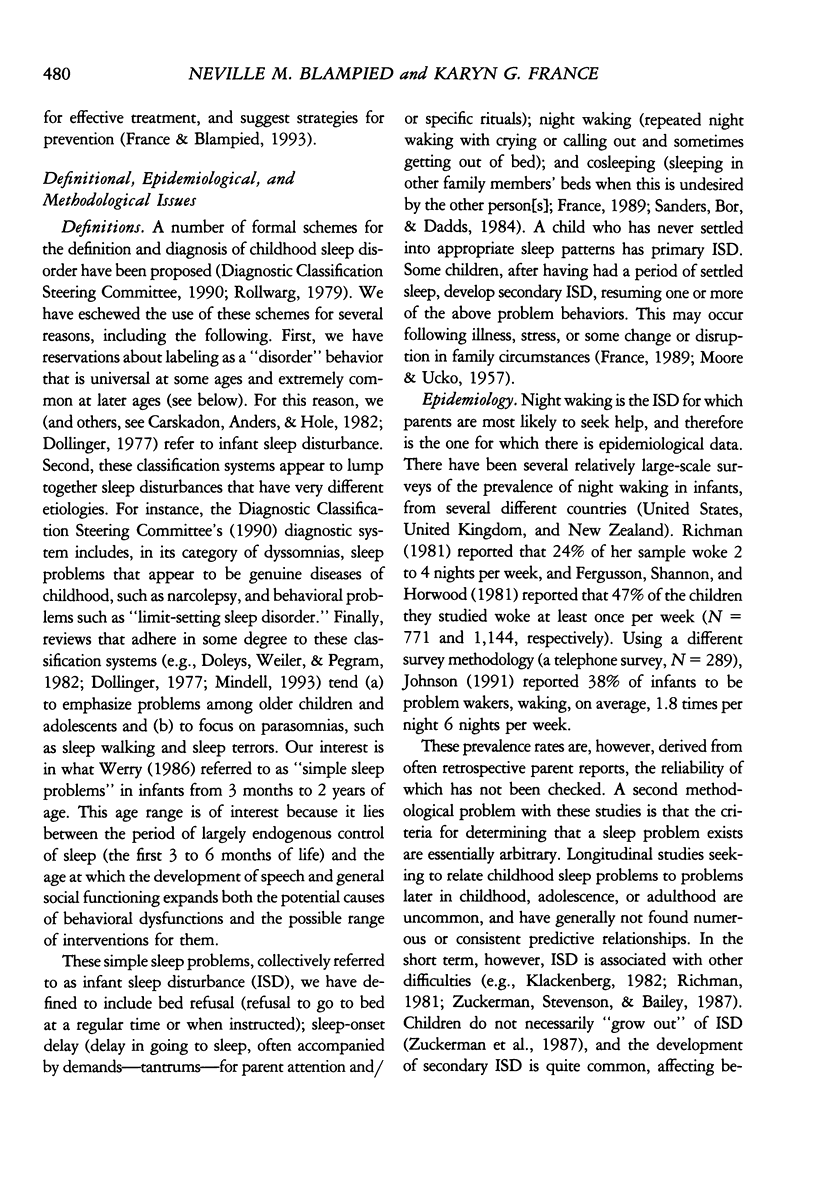
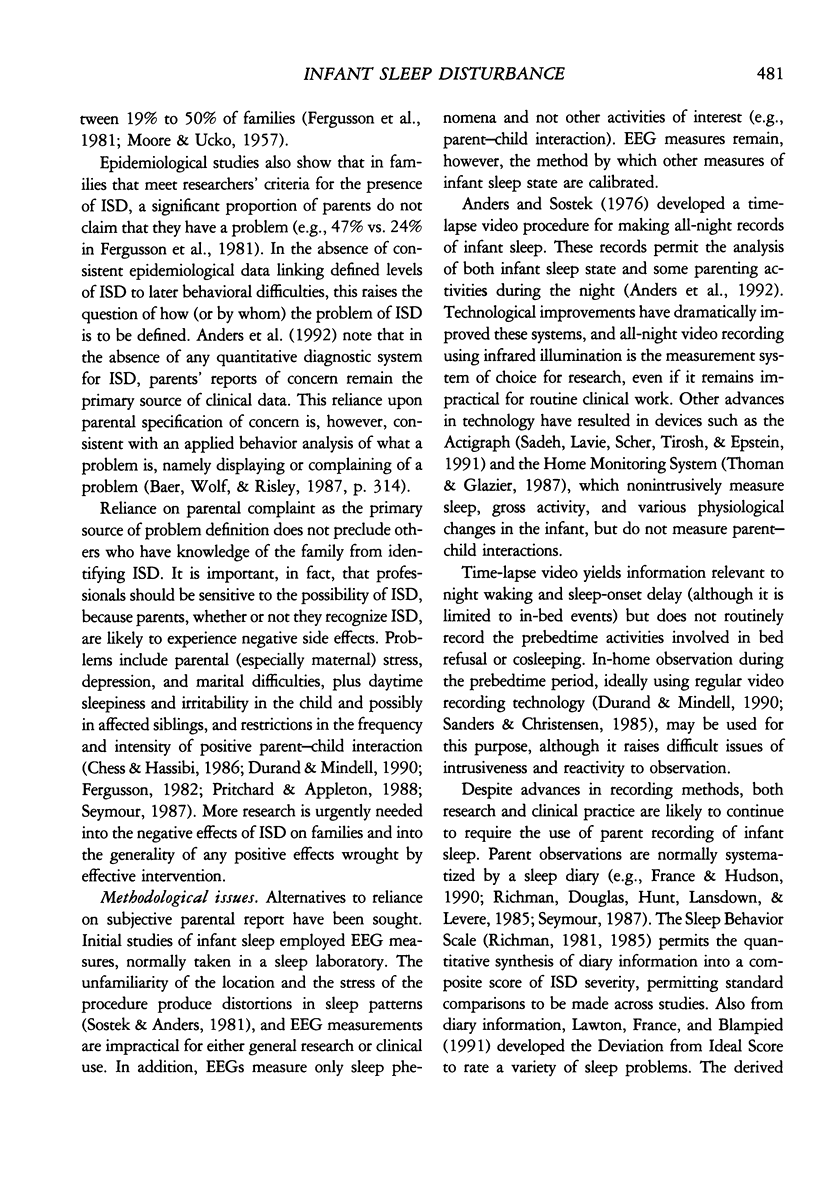
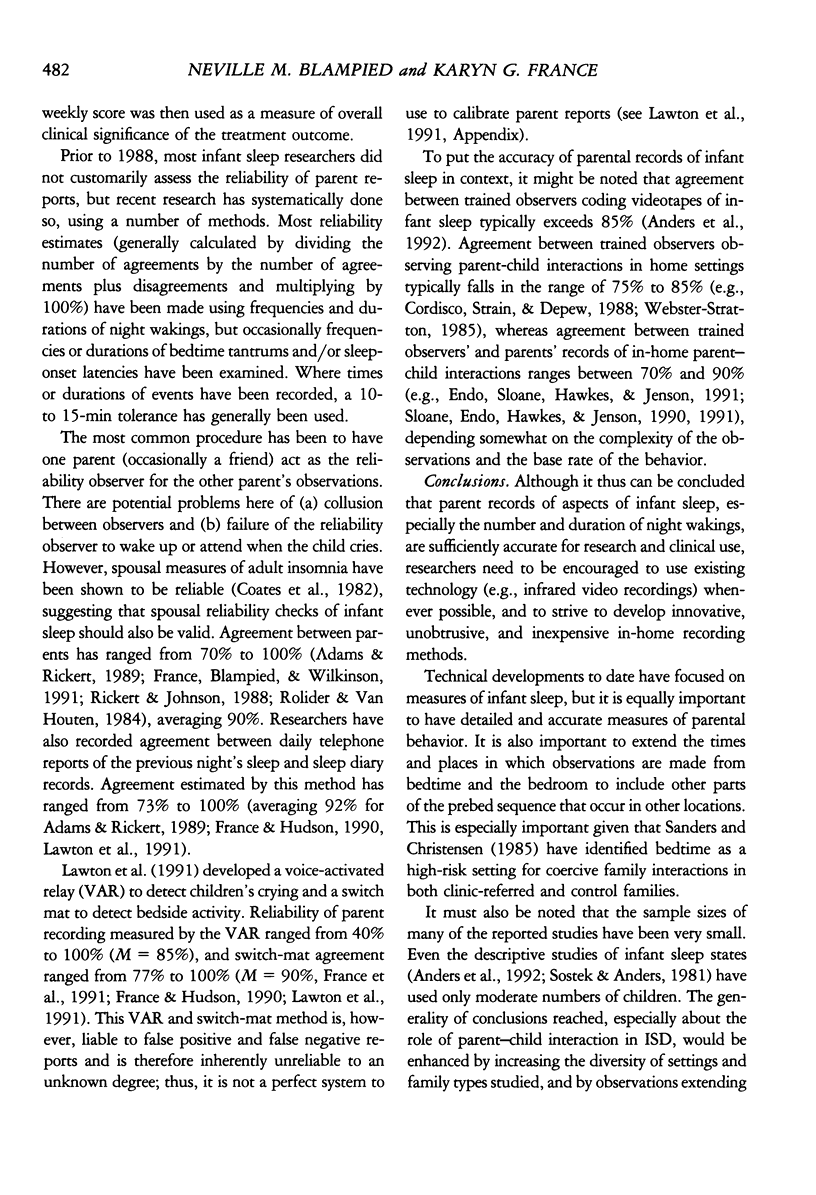
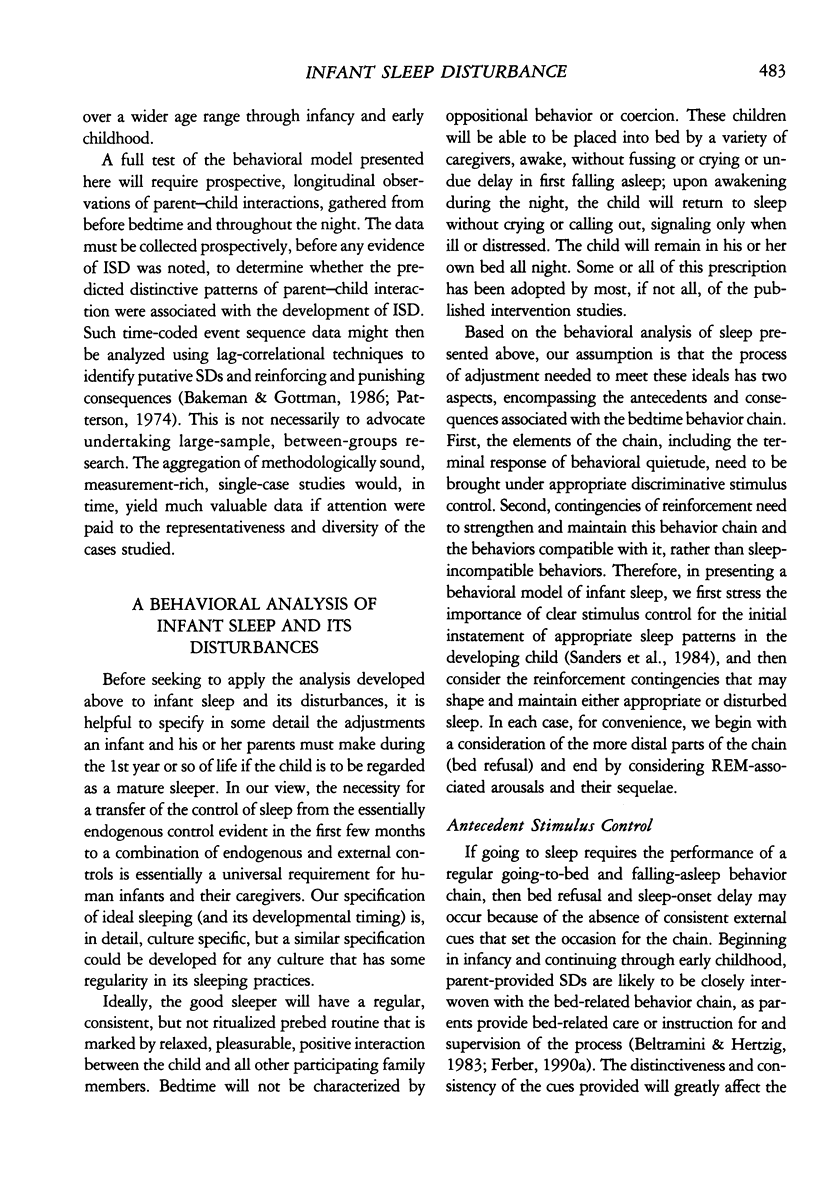


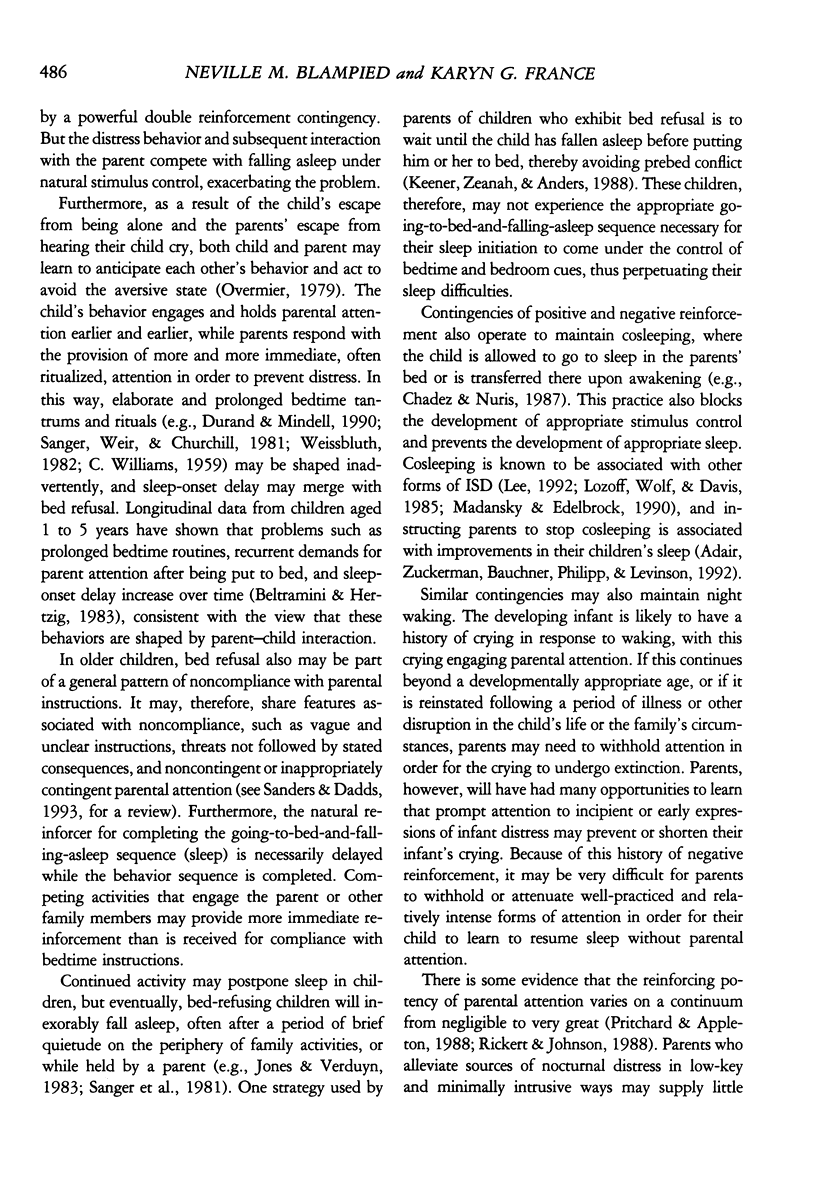
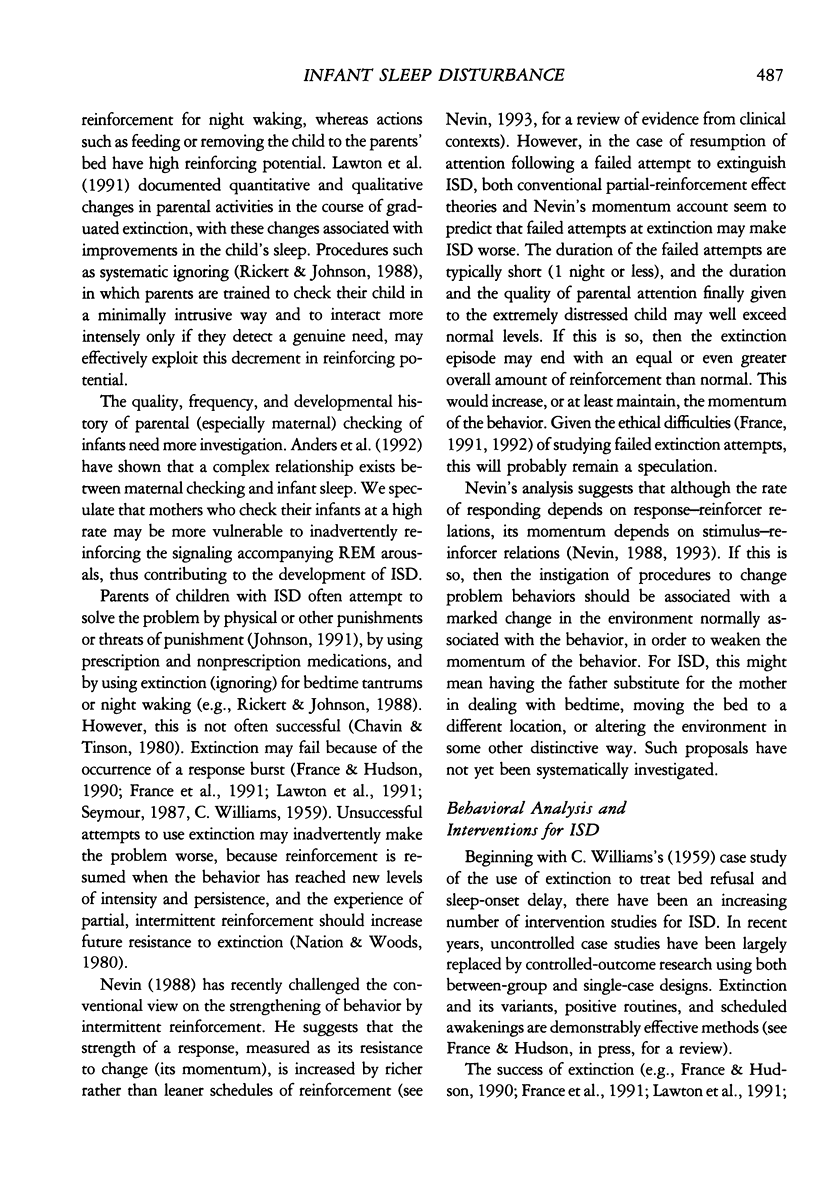
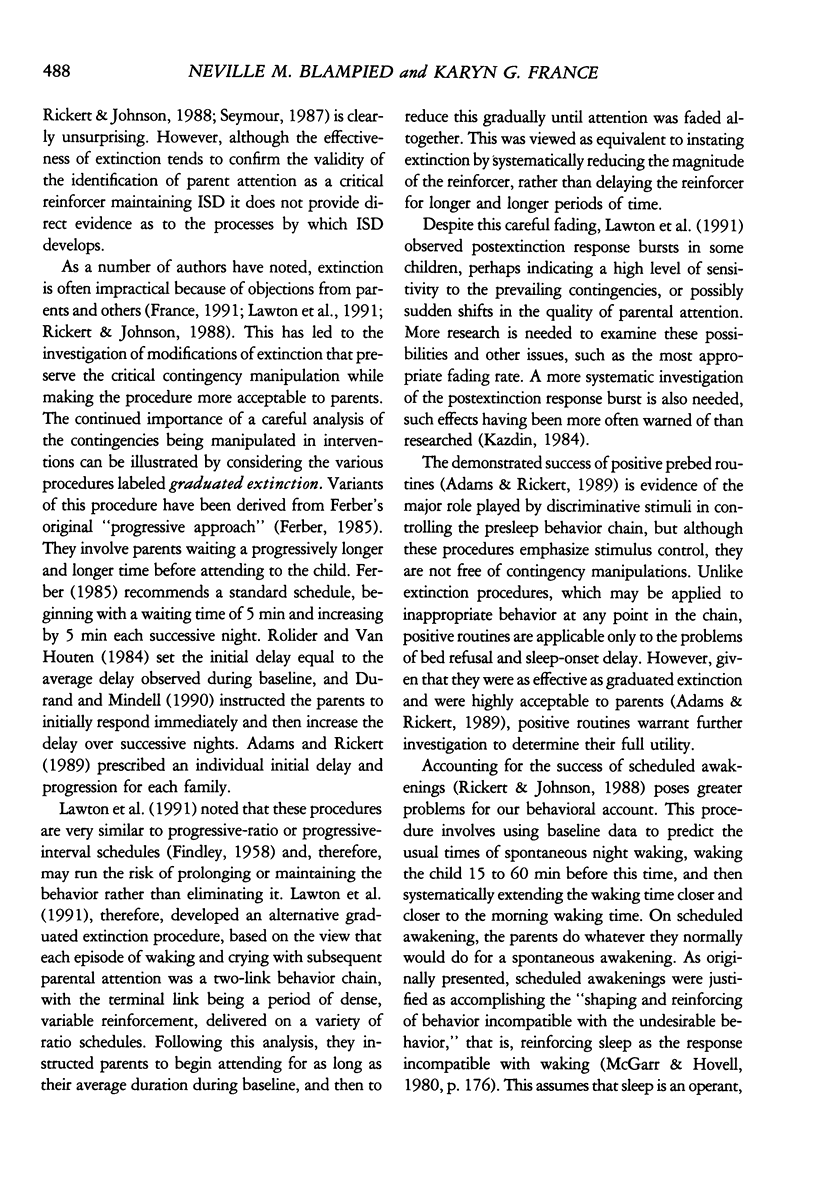

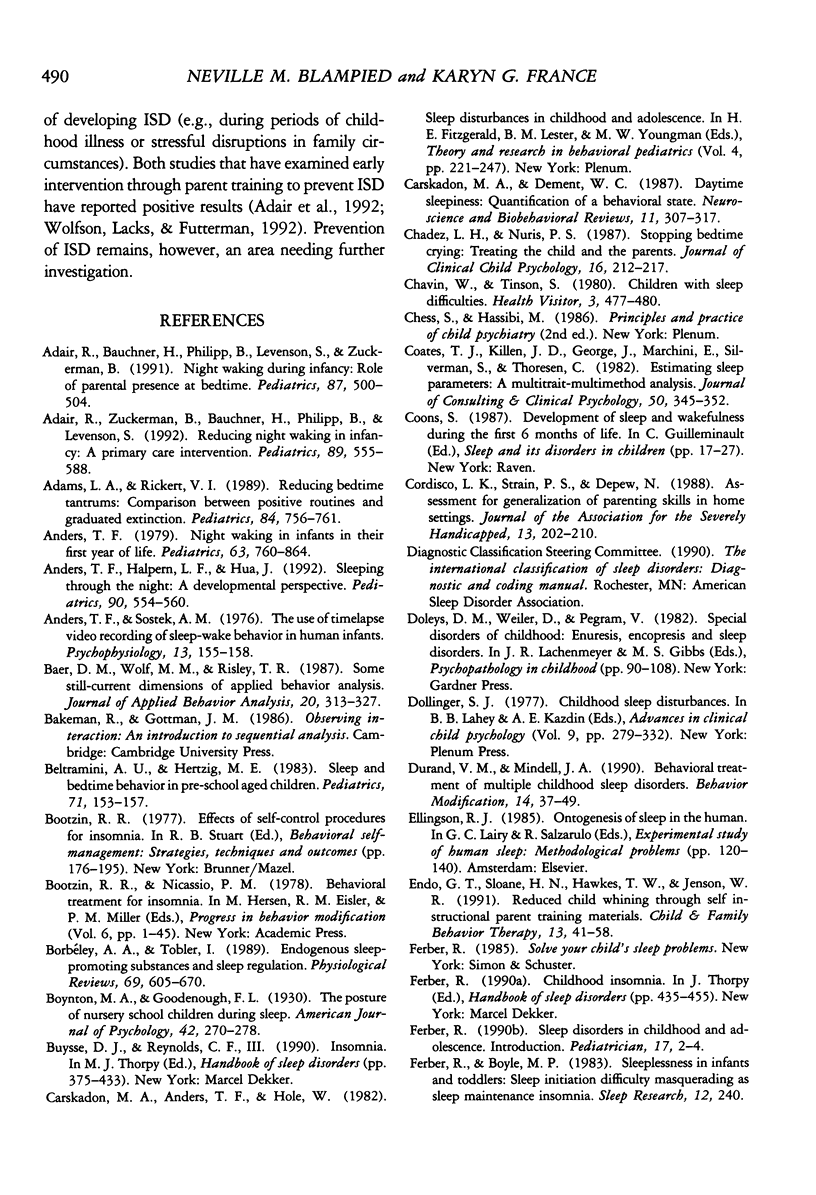


Selected References
These references are in PubMed. This may not be the complete list of references from this article.
- Adair R., Bauchner H., Philipp B., Levenson S., Zuckerman B. Night waking during infancy: role of parental presence at bedtime. Pediatrics. 1991 Apr;87(4):500–504. [PubMed] [Google Scholar]
- Adair R., Zuckerman B., Bauchner H., Philipp B., Levenson S. Reducing night waking in infancy: a primary care intervention. Pediatrics. 1992 Apr;89(4 Pt 1):585–588. [PubMed] [Google Scholar]
- Adams L. A., Rickert V. I. Reducing bedtime tantrums: comparison between positive routines and graduated extinction. Pediatrics. 1989 Nov;84(5):756–761. [PubMed] [Google Scholar]
- Anders T. F., Halpern L. F., Hua J. Sleeping through the night: a developmental perspective. Pediatrics. 1992 Oct;90(4):554–560. [PubMed] [Google Scholar]
- Anders T. F. Night-waking in infants during the first year of life. Pediatrics. 1979 Jun;63(6):860–864. [PubMed] [Google Scholar]
- Anders T. F., Sostek A. M. The use of time lapse video recording of sleep-wake behavior in human infants. Psychophysiology. 1976 Mar;13(2):155–158. doi: 10.1111/j.1469-8986.1976.tb00092.x. [DOI] [PubMed] [Google Scholar]
- Baer D. M., Wolf M. M. Some still-current dimensions of applied behavior analysis. J Appl Behav Anal. 1987 Winter;20(4):313–327. doi: 10.1901/jaba.1987.20-313. [DOI] [PMC free article] [PubMed] [Google Scholar]
- Beltramini A. U., Hertzig M. E. Sleep and bedtime behavior in preschool-aged children. Pediatrics. 1983 Feb;71(2):153–158. [PubMed] [Google Scholar]
- Borbély A. A., Tobler I. Endogenous sleep-promoting substances and sleep regulation. Physiol Rev. 1989 Apr;69(2):605–670. doi: 10.1152/physrev.1989.69.2.605. [DOI] [PubMed] [Google Scholar]
- Carskadon M. A., Dement W. C. Daytime sleepiness: quantification of a behavioral state. Neurosci Biobehav Rev. 1987 Fall;11(3):307–317. doi: 10.1016/s0149-7634(87)80016-7. [DOI] [PubMed] [Google Scholar]
- Chavin W., Tinson S. The developing child: children with sleep difficulties. Health Visit. 1980 Nov;53(11):477–480. [PubMed] [Google Scholar]
- Coates T. J., Killen J. D., George J., Marchini E., Silverman S., Thoresen C. Estimating sleep parameters: a multitrait--multimethod analysis. J Consult Clin Psychol. 1982 Jun;50(3):345–352. [PubMed] [Google Scholar]
- Diagnostic classification of sleep and arousal disorders. 1979 first edition. Association of Sleep Disorders Centers and the Association for the Psychophysiological Study of Sleep. Sleep. 1979 Autumn;2(1):1–154. [PubMed] [Google Scholar]
- Durand V. M., Mindell J. A. Behavioral treatment of multiple childhood sleep disorders. Effects on child and family. Behav Modif. 1990 Jan;14(1):37–49. doi: 10.1177/01454455900141003. [DOI] [PubMed] [Google Scholar]
- Ferber R. Sleep disorders in childhood and adolescence. Introduction. Pediatrician. 1990;17(1):2–4. [PubMed] [Google Scholar]
- Findley J. D. Preference and Switching under Concurrent Scheduling. J Exp Anal Behav. 1958 Apr;1(2):123–144. doi: 10.1901/jeab.1958.1-123. [DOI] [PMC free article] [PubMed] [Google Scholar]
- France K. G. Behavior characteristics and security in sleep-disturbed infants treated with extinction. J Pediatr Psychol. 1992 Aug;17(4):467–475. doi: 10.1093/jpepsy/17.4.467. [DOI] [PubMed] [Google Scholar]
- France K. G., Blampied N. M., Wilkinson P. Treatment of infant sleep disturbance by trimeprazine in combination with extinction. J Dev Behav Pediatr. 1991 Oct;12(5):308–314. [PubMed] [Google Scholar]
- France K. G., Hudson S. M. Behavior management of infant sleep disturbance. J Appl Behav Anal. 1990 Spring;23(1):91–98. doi: 10.1901/jaba.1990.23-91. [DOI] [PMC free article] [PubMed] [Google Scholar]
- Holliday J., Sibbald B., Tooley M. Sleep problems in two-year-olds. Fam Pract. 1987 Mar;4(1):32–35. doi: 10.1093/fampra/4.1.32. [DOI] [PubMed] [Google Scholar]
- Johnson C. M. Infant and toddler sleep: a telephone survey of parents in one community. J Dev Behav Pediatr. 1991 Apr;12(2):108–114. [PubMed] [Google Scholar]
- Jones D. P., Verduyn C. M. Behavioural management of sleep problems. Arch Dis Child. 1983 Jun;58(6):442–444. doi: 10.1136/adc.58.6.442. [DOI] [PMC free article] [PubMed] [Google Scholar]
- Keener M. A., Zeanah C. H., Anders T. F. Infant temperament, sleep organization, and nighttime parental interventions. Pediatrics. 1988 Jun;81(6):762–771. [PubMed] [Google Scholar]
- Klackenberg G. Sleep behaviour studied longitudinally. Data from 4-16 years on duration, night-awakening and bed-sharing. Acta Paediatr Scand. 1982 May;71(3):501–506. doi: 10.1111/j.1651-2227.1982.tb09459.x. [DOI] [PubMed] [Google Scholar]
- MOORE T., UCKO L. E. Night waking in early infancy. I. Arch Dis Child. 1957 Aug;32(164):333–342. doi: 10.1136/adc.32.164.333. [DOI] [PMC free article] [PubMed] [Google Scholar]
- Madansky D., Edelbrock C. Cosleeping in a community sample of 2- and 3-year-old children. Pediatrics. 1990 Aug;86(2):197–203. [PubMed] [Google Scholar]
- Michael J. Distinguishing between discriminative and motivational functions of stimuli. J Exp Anal Behav. 1982 Jan;37(1):149–155. doi: 10.1901/jeab.1982.37-149. [DOI] [PMC free article] [PubMed] [Google Scholar]
- Mindell J. A. Sleep disorders in children. Health Psychol. 1993 Mar;12(2):151–162. doi: 10.1037//0278-6133.12.2.151. [DOI] [PubMed] [Google Scholar]
- Nation J. R., Woods D. J. Persistence: the role of partial reinforcement in psychotherapy. J Exp Psychol. 1980 Jun;109(2):175–207. [PubMed] [Google Scholar]
- Patterson G. R. A basis for identifying stimuli which control behaviors in natural settings. Child Dev. 1974 Dec;45(4):900–911. [PubMed] [Google Scholar]
- Rechtschaffen A., Gilliland M. A., Bergmann B. M., Winter J. B. Physiological correlates of prolonged sleep deprivation in rats. Science. 1983 Jul 8;221(4606):182–184. doi: 10.1126/science.6857280. [DOI] [PubMed] [Google Scholar]
- Richman N. A community survey of characteristics of one- to two- year-olds with sleep disruptions. J Am Acad Child Psychiatry. 1981 Spring;20(2):281–291. doi: 10.1016/s0002-7138(09)60989-4. [DOI] [PubMed] [Google Scholar]
- Richman N. A double-blind drug trial of treatment in young children with waking problems. J Child Psychol Psychiatry. 1985 Jul;26(4):591–598. doi: 10.1111/j.1469-7610.1985.tb01643.x. [DOI] [PubMed] [Google Scholar]
- Richman N., Douglas J., Hunt H., Lansdown R., Levere R. Behavioural methods in the treatment of sleep disorders--a pilot study. J Child Psychol Psychiatry. 1985 Jul;26(4):581–590. doi: 10.1111/j.1469-7610.1985.tb01642.x. [DOI] [PubMed] [Google Scholar]
- Rickert V. I., Johnson C. M. Reducing nocturnal awakening and crying episodes in infants and young children: a comparison between scheduled awakenings and systematic ignoring. Pediatrics. 1988 Feb;81(2):203–212. [PubMed] [Google Scholar]
- SKINNER B. F. Behaviorism at fifty. Science. 1963 May 31;140(3570):951–958. doi: 10.1126/science.140.3570.951. [DOI] [PubMed] [Google Scholar]
- Sadeh A., Lavie P., Scher A., Tirosh E., Epstein R. Actigraphic home-monitoring sleep-disturbed and control infants and young children: a new method for pediatric assessment of sleep-wake patterns. Pediatrics. 1991 Apr;87(4):494–499. [PubMed] [Google Scholar]
- Sanders M. R., Christensen A. P. A comparison of the effects of child management and planned activities training in five parenting environments. J Abnorm Child Psychol. 1985 Mar;13(1):101–117. doi: 10.1007/BF00918375. [DOI] [PubMed] [Google Scholar]
- Sanger S., Weir K., Churchill E. Treatment of sleep problems: the use of behavioural modification techniques by health visitors. Health Visit. 1981 Oct;54(10):421–424. [PubMed] [Google Scholar]
- Thoman E. B., Glazier R. C. Computer scoring of motility patterns for states of sleep and wakefulness: human infants. Sleep. 1987 Apr;10(2):122–129. doi: 10.1093/sleep/10.2.122. [DOI] [PubMed] [Google Scholar]
- Thoman E. B. Sleeping and waking states in infants: a functional perspective. Neurosci Biobehav Rev. 1990 Spring;14(1):93–107. doi: 10.1016/s0149-7634(05)80165-4. [DOI] [PubMed] [Google Scholar]
- WILLIAMS C. D. The elimination of tantrum behavior by extinction procedures. J Abnorm Soc Psychol. 1959 Sep;59:269–269. doi: 10.1037/h0046688. [DOI] [PubMed] [Google Scholar]
- Webster-Stratton C. Comparisons of behavior transactions between conduct-disordered children and their mothers in the clinic and at home. J Abnorm Child Psychol. 1985 Jun;13(2):169–183. doi: 10.1007/BF00910640. [DOI] [PubMed] [Google Scholar]
- Weissbluth M. Modification of sleep schedule with reduction of night waking: a case report. Sleep. 1982;5(3):262–266. doi: 10.1093/sleep/5.3.262. [DOI] [PubMed] [Google Scholar]
- Williams B. A., Dunn R. Substitutability between conditioned and primary reinforcers in discrimination acquisition. J Exp Anal Behav. 1991 Jan;55(1):21–35. doi: 10.1901/jeab.1991.55-21. [DOI] [PMC free article] [PubMed] [Google Scholar]
- Wolfson A., Lacks P., Futterman A. Effects of parent training on infant sleeping patterns, parents' stress, and perceived parental competence. J Consult Clin Psychol. 1992 Feb;60(1):41–48. doi: 10.1037//0022-006x.60.1.41. [DOI] [PubMed] [Google Scholar]
- Zuckerman B., Stevenson J., Bailey V. Sleep problems in early childhood: continuities, predictive factors, and behavioral correlates. Pediatrics. 1987 Nov;80(5):664–671. [PubMed] [Google Scholar]


